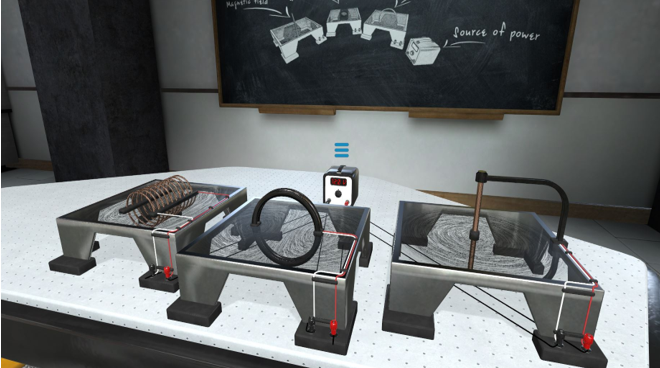

The user is provided with the opportunity to construct various experiments from individual components and then analyze the results to address a given task. The software allows for unlimited repetition of experimental stages. It provides an interactive 3D realistic laboratory for the experimental study of physics. The software features pop-up windows on the left and right sides of the screen during the experiment. These pop-ups contain information regarding the progress of the laboratory work and the calculations needed. They also include the tools necessary for preparing and conducting the laboratory work.
The list of tools in different sections available in the software includes:
● Measuring Cylinder
● Metal Cylinder
● Stand
● Stand Clamp
● Spring with Ruler
● Suspended Weight
● Prism
● Syringe
● Dynamometer
● Weight
● Lever for Stand
● Double Clamp for Stand
● Thermometer (range -10…100 °C)
● Solid Cylindrical Body
● Light Source
● Matte Screen
● Slide with Picture
● Diffraction Grating
● Screen with Vertical Slit
● Rotating Table
● Optical Bench
● Piece of Ice
● 250 ml Beaker
● 500 ml Calorimeter
● Metronome
● Aquarium
● Glass Tube
● Ammeter
● Voltmeter
● Switch
● Power Source
● 1 Ohm Resistor
● Rheostat
● Vertical Rod for Magnets
● Round Magnet
● Pole Magnet
● Particle Track Photo
● Coil
● Core for Coil
● Straight Groove
● Metal Ball
● Curved Groove
● Milliammeter
● Ballistic Gun
● Block
● Test Tube
● Electric Scales
● 2 Ohm Resistor
● 3 Ohm Resistor
● 5 Ohm Resistor
● Solenoid
● Ring for Demonstrating Magnetic Field
● Rod for Demonstrating Magnetic Field
● Float
● 50 g Suspended Weight
● Stopwatch
● Board
● Metal Ball
● Light Bulb
● Laboratory Thermometer (for Calorimeter)
The software contains material on the following sections:
1. Kinematics
2. Statics and Dynamics
3. Molecular Physics and Thermodynamics
4. Direct Current
5. Electricity and Magnetism
6. Optics
The software includes the following minimum list of experiments:
● Mechanics (Kinematics):
○ Lab Work #1: "Determining the Acceleration of a Body in Uniformly Accelerated Motion"
○ Lab Work #2: "Studying the Motion of a Horizontally Thrown Body"
○ Lab Work #3: "Investigating the Relationship Between the Flight Distance of a Body and the Angle of Projection"
● Mechanics (Statics and Dynamics):
○ Lab Work #4: "Studying Elastic Deformations"
○ Lab Work #5: "Studying Archimedes' Principle"
○ Lab Work #6: "Verifying the Condition for Floating Bodies in Liquid"
○ Lab Work #7: "Determining the Work Done in Uniformly Raising a Body"
○ Lab Work #8: "Determining the Condition for Equilibrium of a Lever"
○ Lab Work #9: "Determining the Efficiency of an Inclined Plane"
○ Lab Work #10: "Comparing the Work of Elastic Force with Changes in Kinetic Energy"
○ Lab Work #11: "Determining the Acceleration of Free Fall Using a Mathematical Pendulum"
○ Lab Work #12: "Determining the Speed of Surface Wave Propagation"
● Molecular Physics and Thermodynamics:
○ Lab Work #13: "Determining the Density of Liquids and Solids"
○ Lab Work #14: "Measuring Relative Humidity of Air"
○ Lab Work #15: "Determining Atmospheric Pressure"
○ Lab Work #16: "Measuring the Surface Tension of Water Using Drop Detachment and Liquid Rise in a Capillary"
○ Lab Work #17: "Comparing Molar Heat Capacities of Metals"
○ Lab Work #18: "Determining the Specific Heat of Fusion of Ice"
● Direct Current:
○ Lab Work #19: "Assembling an Electric Circuit and Measuring Current and Voltage in Different Sections"
○ Lab Work #20: "Investigating the Relationship Between Current and Voltage in a Circuit Section. Verifying Ohm's Law"
○ Lab Work #21: "Studying Series and Parallel Connections of Conductors"
○ Lab Work #22: "Measuring the Work and Power of Electric Current"
○ Lab Work #23: "Studying Ohm's Law for a Circuit Section"
○ Lab Work #24: "Studying Mixed Connections of Conductors"
● Electricity and Magnetism:
○ Lab Work #25: "Studying the Properties of Permanent Magnets and Visualizing Magnetic Fields"
○ Lab Work #26: "Assembling an Electromagnet and Studying Its Action"
○ Lab Work #27: "Determining the EMF of a Current Source and Its Internal Resistance"
○ Lab Work #28: "Studying the Phenomenon of Electromagnetic Induction"
● Optics (Wave Optics):
○ Lab Work #29: "Determining the Wavelength of Light Using a Diffraction Grating"
● Optics (Geometric Optics):
○ Lab Work #30: "Determining the Focal Length and Optical Power of a Converging Lens"
○ Lab Work #31: "Determining the Refractive Index of Glass Using Plane-Parallel Plates"
While using the software, users have the ability to start and stop the experiment at their convenience. The elapsed time from the start of the experiment is displayed on the screen. When starting each laboratory work, users can drag any laboratory tool from the toolbar onto the workspace, onto an object located on the workspace, or inside the object on the workspace. If necessary, users can change the direction of the objects, their relative positions, and their sequence. Users also have the ability to modify the initial parameters of tools and laboratory setups during the laboratory work, such as changing the voltage at the power source, the height of the stand clamp, the poles of the magnet, the initial angle of firing with the ballistic gun, and more.
Please leave your message here! We will send detail technical info and quotation to you!